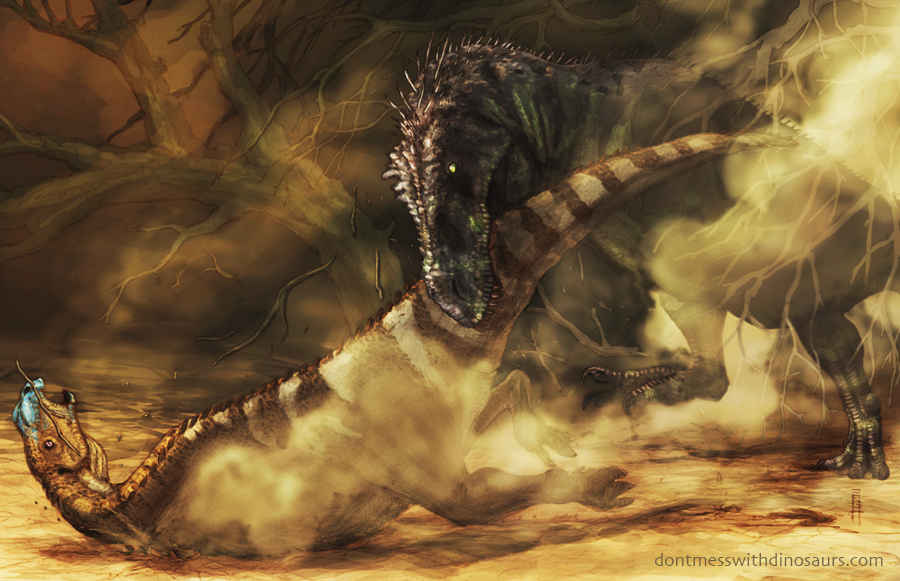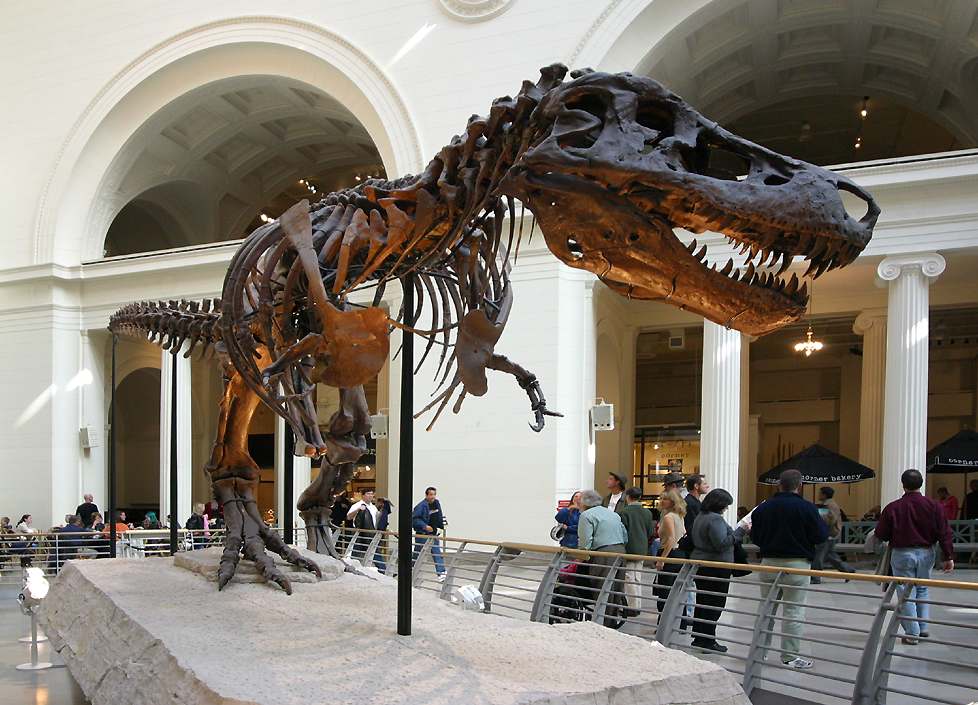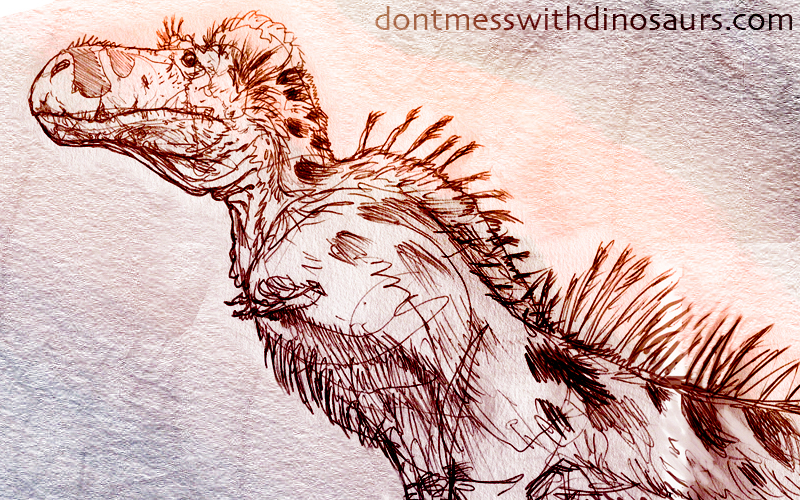What in Hell Creek is a T. Rex?
Seriously. What is this animal?
A few months back I did this illustration of T. rex ambushing a Hadrosaur, inspired by evidence that Tyrannosaurs bit the tails of living Hadrosaurs. I decided to keep the attacking T. rex mostly obfuscated by a cloud of dust partially to give the impression that the Hadrosaur was ambushed as its herd stampeded past a hidden Tyrannosaurus, but also because this mighty predator is a mystery to me.
I was recently at the Field Museum in Chicago looking at Sue again in person, and as I gazed up into that huge bizarre skeleton, I could not ignore an unsettling idea prying at somewhere deep in my childhood psyche: This is not Tyrannosaurus Rex. Those bones were from something different. A creature foreign and bizarre to me from a different world. An animal that looked, moved and fought for survival nothing like what I had grown up imagining as Tyrannosaurus Rex.
For a few years now I’ve been trying to come up with a satisfying reconstruction of a big adult T. Rex but I still haven’t managed one, and in my opinion, none exists from another artist. The necks, legs and tails are all too long, slender and bird-like, the body cavity not deep nor tall enough, the arms too developed looking. I feel like every paleo-artist (including myself) is trying to reconcile the actual skeletal proportions of big Tyrannosaurs with the idea of these animals that the film Jurassic Park made so visually concrete and believable. We want to imagine big Tyrannosaurs as agile hunters chasing down their prey, engaging it in combat, and dispatching it with fatal bites. While some of the smaller species of tyrannosaurs, and the juveniles of T. rex may have been relatively long-legged, the really big ones – the ones we base epic illustrations on – simply weren’t. When I look at the skeletons of the big adult Tyrannosaurs I see a hulking beast with a HUGE body cavity, a massive tail and head, and relatively short thick legs. And yet we have evidence that these massive predators attacked formidable living prey. So what the hell is this animal? How did it live, hunt, and sustain its enormous bulk?
In short, I do not see an agile jungle cat. I see something like an obese crocodile on two thick chicken legs.
I have been kicking around a few ideas for tyrannosaur illustrations (including a reconstruction of Sue) that I want to do in the coming months as I am able to find the time. I know a feathery body covering to the extent that I have drawn in the above doodle is not likely considering scaly skin impressions of tyrannosaurus have been found, but I have been experimenting with different soft tissue reconstructions with the hope of coming up with some new looks for this old giant. Ultimately my aim is to produce some reconstructions that are true to the fossil evidence while at once dramatically depict this seemingly mythical creature as a something more of a real, believable animal.
I think one of the main reasons why dinosaurs (and other extinct monsters) are so awesome is that we can keep imagining new ways they might have been awesome, and ultimately its a pretty safe bet that when these animals were alive they were more awesome than anything we’ve yet come up with. Nature tends to be pretty kick-ass that way.
Ever seen a fossil nautilus?




David on 24 Jan 2011 at 11:51 pm #
I always feel the same way standing under a reconstructed skeleton, especially of a theropod or sauropod. Illustrations are usually based on 2-d representations, and use the bottoms of the ribs to find the silhouette of the gut. Looking at this monster from the front makes that technique seem absurd.
Even Darren Naish, usually so attuned to these issues, drew a line directly at the bottom of the ribs to estimate for his 3-d representation: https://svpow.wordpress.com/2011/01/20/tutorial-11-graphic-double-integration-or-weighing-dinosaurs-on-the-cheap/
I’ve never seen a mounted plateosaurus, but I was suspicious.
On the other hand, maybe we shouldn’t take the mounted skeletons too seriously. It’s unclear how the ribs were arranged, at what angle they met the spine, how curved they really were. You saw the real skull upstairs, how warped and distorted it was? Just imagine the condition of the ribs!
David on 24 Jan 2011 at 11:52 pm #
EDIT: NOT Naish but SVPOW’s Matt Wedel! My bad.
I didn’t mean to hate on his post – it’s still good stuff!
Glendon Mellow on 25 Jan 2011 at 11:53 am #
Interesting that even scientific illustration, the most utilitarian and “truthiest” of the science-based arts can fall prey to fashion.
Wonderful images!
Historian on 25 Jan 2011 at 5:23 pm #
To clarify, my main gripe is that the legs on most large theropods are drawn waaaaaaay too long – as though they were all sprinting around like road-runners. To me their skeletons of the big guys look they were built for more lurking and lunging at prey from cover, rather than chasing.
As far as rib/skull distortion goes, I imagine a skull would likely distort much more than a rib because a skull has so much hollow space inside it. A rib on the other hand is pretty solid. If you drop it on the ground it lies pretty much flat and I imagine sediment would drop on top of it and preserve it’s curvature pretty reliably… but that’s just me speculating, I really have no idea how distorted Sue’s ribs are.
Matt on 30 Jan 2011 at 10:14 am #
Cool post!
I think people can easily forget volume when they reconstruct animals. We need the guts and heart and lungs in there! Then we need reasonably chunky legs to support it all.
I’ve got a new painting of lunging Tarbosaur on the horizon which hopefully addresses some of what you’ve mentioned, though I haven’t been so accurate with the part of the hadrosaur body it’s lunging at!
Matt
Andrew on 31 Jan 2011 at 11:12 pm #
“I feel like every paleo-artist is trying to reconcile the actual skeletal proportions of big Tyrannosaurs with the idea of these animals that the film Jurassic Park made so visually concrete and believable.”
Very well said, sir. It’s kinda funny to consider the extent to which popular reconstructions of dinosaurs have influenced our scientific ones. Go back to the bare bones, tune out what everyone thinks these animals should look like and reimagine something that really existed at one time. Noble task.
JJ on 06 Feb 2011 at 1:29 am #
This is one of my favorite dinosaur re-imaginings I’ve ever seen! Really great, I cant wait to see more! I’d love how these ideas are super fresh, but grounded in biology. Your Sauroposeidon blew my mind, and now this? Amazing!
Yeah, I cant wait to see more!
Harry on 07 Apr 2011 at 7:04 pm #
I’d like to see a T.rex skeleton reconstructed more on the lines of a chicken skeleton. Has anyone seen (or perhaps done) that?
Historian on 08 Apr 2011 at 3:11 am #
How do you mean?
Ragnar on 22 Nov 2011 at 3:59 pm #
I have always thought that sculptors and artists never put enough flesh on the skull of threapods. I would expect massive masseter muscles and more padding in general on the face. To me, these artists are just colouring the skull. I suppose the idea that the lip is open at the back edge comes from looking at alligators, but I still wonder about this…
Ragnar on 22 Nov 2011 at 4:00 pm #
oops – therapods, not threapods!
dontmesswithdinosaurs.com » T. rex’s skull shattering bite on 25 Sep 2019 at 3:10 pm #
[…] reptilian-looking tyrannosaur reconstructions people are used to, and that’s fine, I’ve been balking at all that paleoart ever since I first saw the grotesque relics of the T. rex named Sue back in […]